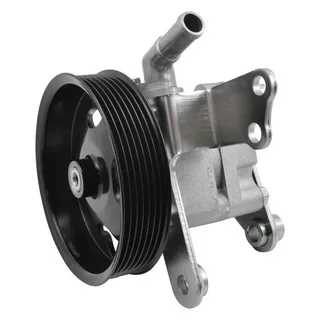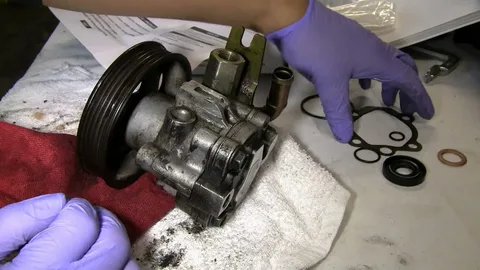Have you ever wondered how effortless it feels to turn the steering wheel of your car? The answer lies in the Ve power steering pump. This crucial component of your vehicle’s steering system plays a significant role in ensuring a smooth and comfortable driving experience.
How a Power Steering Pump Works
The power steering pump is responsible for assisting the driver in turning the steering wheel with minimal effort. It is typically driven by the engine through a belt and uses hydraulic pressure to amplify the force applied by the driver. The pump is connected to the steering gear, which applies the necessary force to turn the wheels. Inside the pump, there is a rotor that rotates when the engine is running. As the rotor spins, it creates a vacuum that draws in power steering fluid from the reservoir. This fluid is then pressurized and sent to the steering gear, allowing for easier steering.
 Benefits of a Ve Power Steering Pump
Benefits of a Ve Power Steering Pump
Investing in a Ve Power Steering Pump can greatly enhance your driving experience. Here are some key benefits:
1. Improved Steering Control
The primary advantage of a power steering pump is the enhanced control it provides over your vehicle’s steering. By reducing the effort required to turn the wheel, it allows you to navigate corners, maneuver through tight spaces, and smoothly change lanes with ease. This not only improves your driving experience but also enhances safety on the road.
2. Reduced Driver Fatigue
Turning the steering wheel of a vehicle without power steering can be physically demanding, especially during long drives or when parking in cramped spaces. With a power steering pump, the strain on your arms and shoulders is significantly reduced, preventing fatigue and discomfort. You can enjoy extended journeys without feeling exhausted from the constant effort required to steer your vehicle.
3. Enhanced Driving Comfort
A smooth and comfortable ride is something every driver desires. With a power steering pump, you can achieve just that. The ease of steering provided by the pump ensures a seamless driving experience, minimizing vibrations and jolts that may occur when wrestling with a non-power-assisted steering system. Say goodbye to the jerky movements and hello to a more enjoyable ride.
Signs of a Failing Power Steering Pump
While power steering pumps are designed to be durable, they can experience issues over time. Recognizing the signs of a failing pump is crucial to address any problems promptly. Here are some common indicators to watch out for:
1. Difficulty Turning the Wheel
If you notice that it has become increasingly difficult to turn the steering wheel, it could be a sign of a failing power steering pump. This may manifest as stiffness or resistance when trying to maneuver the vehicle, especially at lower speeds or during parking.
2. Whining or Groaning Noises
Unusual noises, such as whining or groaning, coming from the steering system may indicate a problem with the power steering pump. These noises can occur when the pump is not receiving enough fluid or when there is air trapped in the system. Ignoring these noises can lead to further damage and potentially costly repairs.
3. Leaking Power Steering Fluid
Power steering fluid is essential for the proper functioning of the pump. If you notice puddles or stains of fluid underneath your vehicle, it could be a sign of a leak in the power steering system. Leaking fluid can cause a drop in hydraulic pressure, resulting in poor steering performance.
Power Steering Pump Maintenance Tips
Proper maintenance of your power steering pump is vital to ensure its longevity and optimal performance. Here are some maintenance tips to keep in mind:
1. Regularly Check Power Steering Fluid Levels
Checking the power steering fluid levels should be a part of your routine vehicle maintenance. Low levels of fluid can lead to pump failure and cause damage to other steering components. Refer to your vehicle’s manual for the correct procedure to check and add fluid if necessary.
2. Flush and Replace Power Steering Fluid
Over time, power steering fluid can become contaminated with dirt, debris, and moisture, which can affect the pump’s performance. It is recommended to flush and replace the fluid according to the manufacturer’s guidelines to maintain a clean and well-lubricated system.
3. Inspect Belts and Hoses
Regularly inspect the belts and hoses connected to the power steering pump for any signs of wear, cracks, or leaks. Faulty belts can lead to a loss of power assistance, while deteriorated hoses can cause fluid leaks. Replace any damaged components promptly to prevent further issues.
Choosing the Right Power Steering Pump for Your Vehicle
When it comes to selecting a power steering pump for your vehicle, there are a few factors to consider. Here are some key points to keep in mind:
1. Compatibility with Your Vehicle
Ensure that the power steering pump you choose is compatible with your specific make and model of vehicle. Different vehicles may have varying specifications, such as pump capacity and mounting requirements. Consult your vehicle’s manual or seek professional advice to select the right pump.
2. Quality and Reliability
Investing in a high-quality power steering pump is essential for long-term performance and durability. Look for reputable brands that have a track record of producing reliable and robust pumps. Reading customer reviews and seeking recommendations can also help in making an informed decision.
3. Warranty Coverage
Check the warranty coverage provided by the manufacturer. A warranty demonstrates the confidence the manufacturer has in their product. Opt for a power steering pump that offers a reasonable warranty period, as it provides peace of mind and protection against any potential defects or failures.
Power Steering Pump Installation Process
It is recommended to have a professional mechanic install or replace a power steering pump. However, if you have the necessary skills and knowledge, you can attempt the installation yourself. Here is a general overview of the installation process:
- Begin by disconnecting the negative battery cable to prevent any electrical mishaps during the installation.
- Locate the power steering pump in your vehicle’s engine bay and remove any components obstructing access to it.
- Drain the power steering fluid from the system by disconnecting the hoses and allowing the fluid to drain into a suitable container.
- Remove the mounting bolts securing the old pump and carefully detach it from the vehicle.
- Install the new power steering pump in the reverse order, ensuring proper alignment and torque specifications.
- Reconnect the hoses and fill the power steering system with the recommended fluid.
- Start the engine and turn the steering wheel from lock to lock several times to remove any air bubbles from the system.
- Check for leaks and proper steering functionality before driving the vehicle.
It is important to consult your vehicle’s manual or seek professional guidance for specific instructions related to your vehicle’s make and model.
Conclusion
A power steering pump is an essential component of your vehicle’s steering system, providing enhanced control, reduced driver fatigue, and a more comfortable driving experience. By recognizing the signs of a failing pump, performing regular maintenance, and choosing the right pump for your vehicle, you can ensure optimal performance and longevity. In case of any issues, consult a professional mechanic for proper diagnosis and repair. Enjoy the benefits of a smooth ride with a properly functioning power steering pump.
FAQs
Q: How often should I check the power steering fluid levels?
A: It is advisable to check the power steering fluid levels during routine vehicle maintenance, typically every few months or as recommended in your vehicle’s manual.
Q: Can I drive my car with a failing power steering pump?
A: It is not recommended to drive your car with a failing power steering pump as it can lead to increased effort required to steer the vehicle and potential damage to other steering components.
Q: How long does a power steering pump typically last?
A: The lifespan of a power steering pump can vary depending on factors such as usage, maintenance, and driving conditions. On average, a well-maintained pump can last between 80,000 to 150,000 miles.
Q: Can I replace a power steering pump myself?
A: While it is possible to replace a power steering pump yourself, it is recommended to have a professional mechanic perform the installation to ensure proper alignment and functionality.
Q: What should I do if I notice a power steering fluid leak?
A: If you notice a power steering fluid leak, it is important to identify and repair the source of the leak promptly. Continued driving with a leak can lead to a loss of hydraulic pressure and potential damage to the power steering system.



